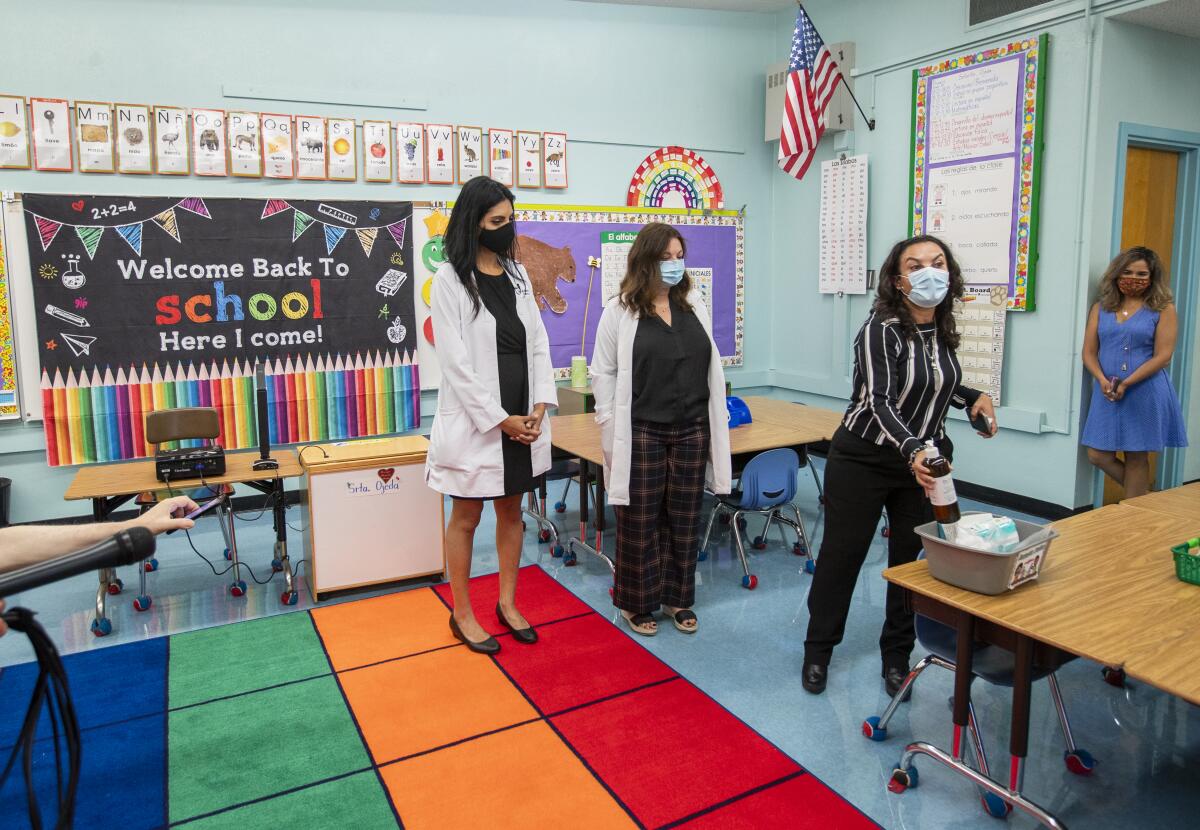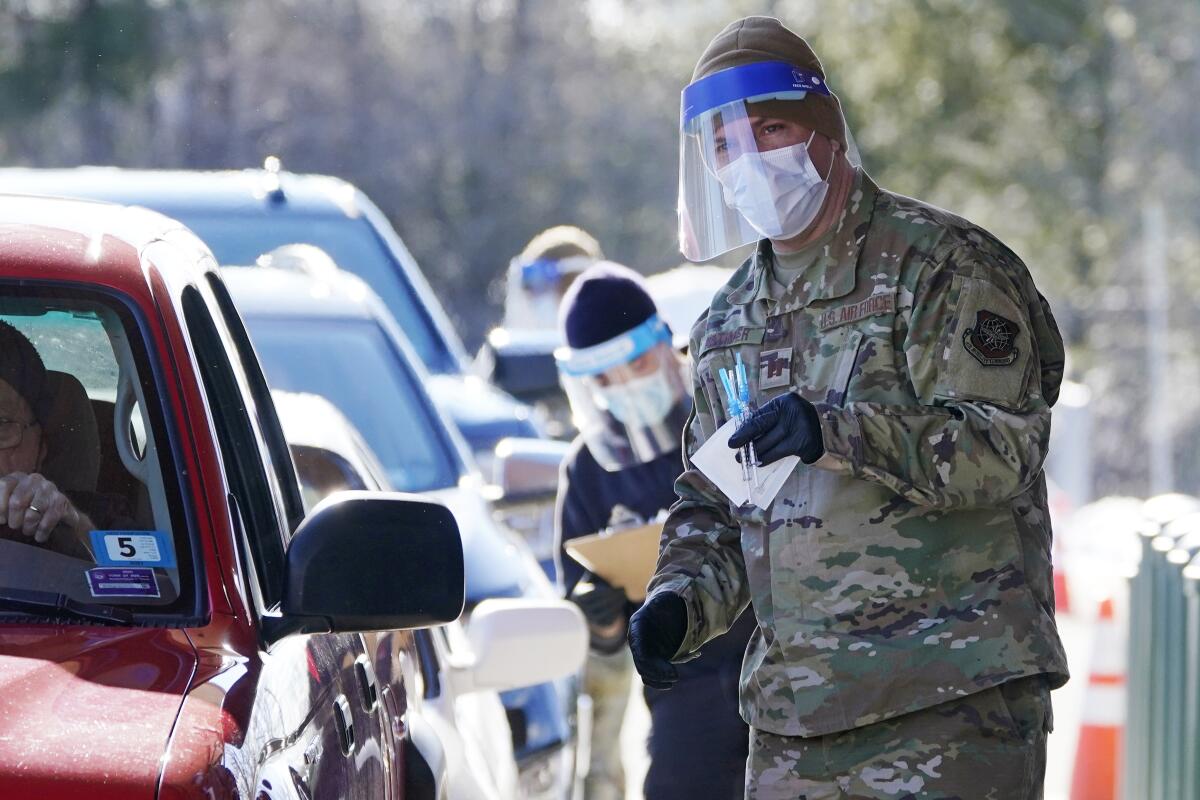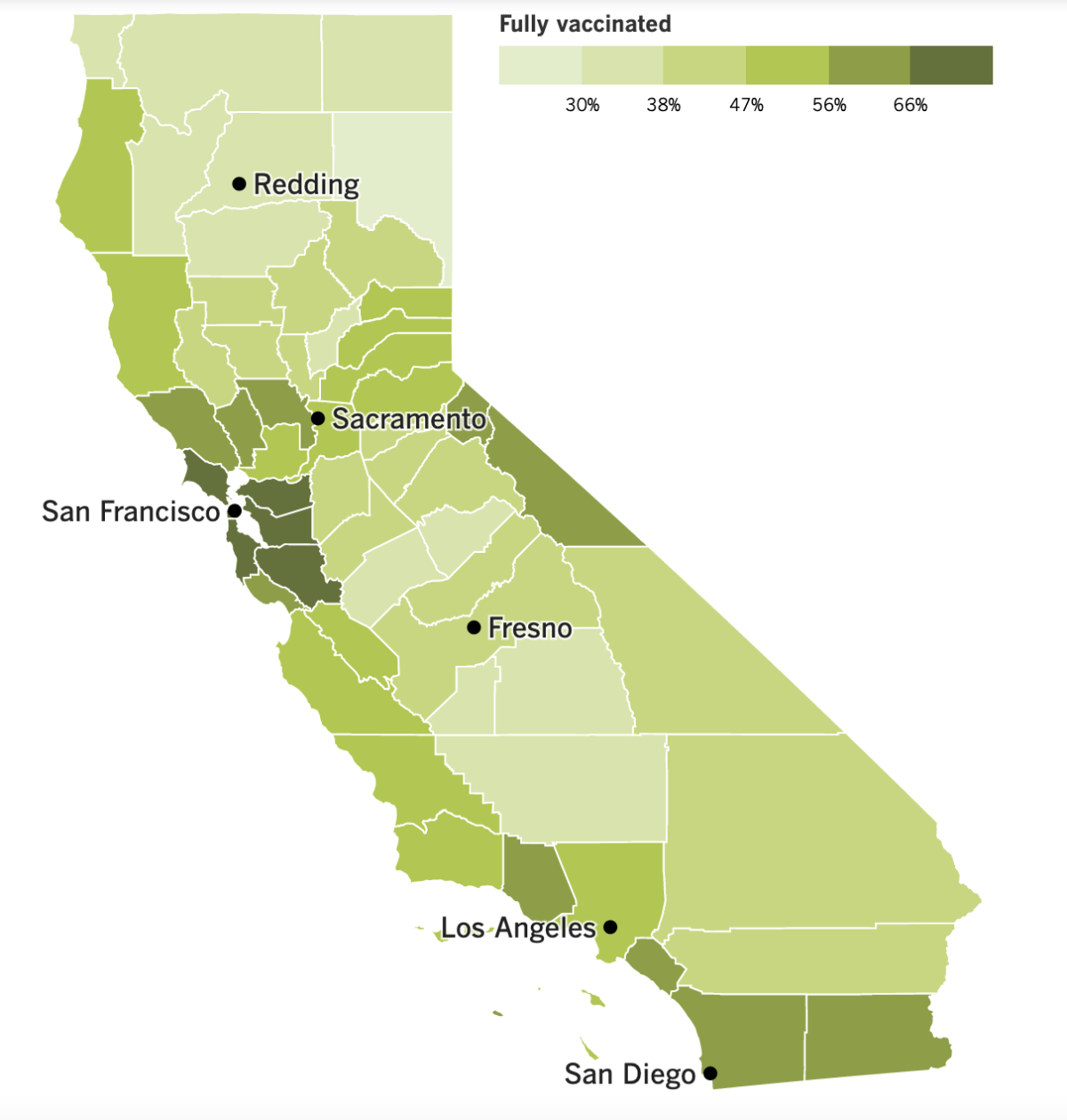Coronavirus Today: Back-to-school blues
- Share via
Good evening. I’m Karen Kaplan, back from a week away, and it’s Tuesday, Aug. 10. Here’s the latest on what’s happening with the coronavirus in California and beyond.
In a few days, my kids will be starting a new school year. It’ll be their first time back in classrooms since things shut down abruptly 17 months ago. It’s a huge milestone on the road back to normal life, and I’d like to be more excited about it. But there’s one thing getting in the way — the Delta variant.
This was not what I expected when school ended in June. At the time, coronavirus infections were plummeting, COVID-19 vaccinations were rising, and the state was on the verge of reopening the economy. The end of the pandemic seemed to be in sight.
No longer.
California is averaging 11,211 new coronavirus cases per day over the past week, a figure that’s almost twice as high as it was two weeks ago. And the number of coronavirus-infected people in California hospitals doubled in just two weeks, rising from 2,981 on July 25 to 5,973 on Sunday.
This new wave includes outbreaks among school-age children. Seven of them occurred in Los Angeles County in the last week of July — the most since December, when we were in the midst of a devastating surge. County officials say most of these recent outbreaks were associated with youth sports, especially in situations where safety precautions like mask-wearing and physical distancing weren’t taken seriously.
Barbara Ferrer, the county’s public health director, said that there were 319 confirmed coronavirus cases among kids 11 and under in the two weeks ending July 24, up from just 47 in the two-week period ending June 26. Among adolescents ages 12 to 17, cases rose from 34 to 211.
Though these numbers are still small compared to the worst days of fall-and-winter surge, they’re hardly reassuring.
“We recognize that, given our recent increases in cases, there is anxiety around school reopening,” Ferrer said.

If you are feeling some of that anxiety, know that you’re not alone. My colleague Howard Blume found plenty of parents who are right there with you.
“I wanted to be excited about a new school year, but now I am having to think: ‘Am I putting our health at risk by going to school in person?’” said Irma Villalpando, a mother of two students at the Maywood Center for Enriched Studies. “I am feeling very sad because I think that it is going to be another very difficult year.”
Part of what makes things difficult is the all-or-nothing approach school districts are taking. Hybrid learning was far from perfect, but without it, the choices boil down to two unappealing options: Full-time, on campus-instruction with face masks but no requirements for physical distancing, or an online option that’s essentially an independent-study program.
As Blume points out, health officials argue that schools can operate safely at their usual capacity as long as they take other preventive measures, such as stepping up their cleaning and hygiene practices, installing better air filters and making sure students, teachers and staff members stay home if they are sick.
If it’s discovered that an infected person has been on campus, L.A. County officials will engage in aggressive contact tracing. Those with infections will be required to isolate themselves, and close contacts will need to quarantine for up to 10 days unless they are vaccinated. In some cases, groups of students or even an entire class could be asked to remain at home, but wholesale closures of schools are unlikely, Ferrer said.
Even so, many parents are bracing for a choppy year ahead.
“I thought I would be sending my children back,” said DeAnne Ozaki, whose children are in the Santa Monica-Malibu Unified School District. “My daughter is vaccinated, and I was hoping that the number of COVID cases would be low and it would be safe for my son. Unfortunately, the Delta variant has changed everything.”
By the numbers
California cases, deaths and vaccinations as of 6:20 p.m. Tuesday:

Track California’s coronavirus spread and vaccination efforts — including the latest numbers and how they break down — with our graphics.
How partisan politics is literally killing us
I don’t envy Steve Allender. He’s the Republican mayor of Rapid City, S.D., and he spent more than a year urging people to protect themselves against COVID-19. That includes wearing masks, avoiding crowds and getting vaccinated.
How were his efforts to keep his constituents safe rewarded? With people harassing him at public meetings and staking out his home.
The intimidation campaign worked. By early summer, he had given up. Only 34.7% of residents in Pennington County, where Rapid City is located, are vaccinated, and coronavirus activity there is classified as “high” by the Centers for Disease Control and Prevention.
“Our role is just to sit back and let it happen,” he told my colleagues in an interview. “I feel like a bit of a coward.”
He’s not the only one.
David Trujillo, the mayor of Lovington, N.M., was one of the first residents of Lea County to get vaccinated. He’s a Democrat in a rural county that Donald Trump won in November by 60 percentage points. With only 21% of the county fully vaccinated, he said he’s got little to gain — and much to lose — by talking up the shots.
“It’s a hard sell here,” said Trujillo, who is up for reelection in April. “You could lose votes for pushing the vaccine too much.”
My colleagues reached out to the mayors or town managers of the counties with the lowest vaccination rate in each state. Twenty-six officials were willing to talk with them, and they found that “the majority expressed deep frustration at the way politics had infected the campaign to inoculate enough Americans to wipe out the virus.”

Another theme: The mayors who supported vaccination felt they’d done everything they could and there was nothing left for them to try that might persuade people to get the shots.
“It’s disappointing,” said Mayor Allen Brown, an independent who leads Texarkana, Ark. Only 9.3% of residents in surrounding Miller County are fully vaccinated.
Trump won Miller County by more than 46 percentage points, and that fits a trend: In most cases, the counties with the lowest vaccination rates were among the most ardent supporters of the former president (who, it should be noted, accelerated the development of COVID-19 vaccines through Operation Warp Speed and got the shots himself).
Several of the mayors my colleagues talked to said vaccine misinformation was to blame for their low vaccination rates.
“Rumors go around that they’re putting something in [the vaccines] to track you,” said Roger Taylor, the Democratic mayor of Pawhuska, Okla.
Some mayors also pointed to a deep distrust of scientists, public health experts and the federal government.
Reece Keener, the unvaccinated Republican mayor of Elko, Nev., is partial to the view that the dangers of the pandemic have been exaggerated. He told my colleagues he was sick of “an overabundance of ‘fear porn’ that’s being broadcasted everywhere” and blamed “contradictions and confusing messaging from the CDC” for keeping Elko County’s vaccination rate at 29.6%.
The irony is that people like Keener are in the best position to change people’s minds.
A poll last month by the Kaiser Family Foundation found that only 54% of Republicans surveyed had received at least one dose of COVID-19 vaccine, compared with 86% of Democrats. And according to a new study published in the Proceedings of the National Academy of Sciences, unvaccinated Republicans were more likely to roll up their sleeves in response to an appeal from a Republican politician than one from a Democrat.
Trump won Winston County, Ala., by 82 percentage points. Only 14.9% of residents there are fully vaccinated. But Elmo Robinson, the vaccinated Democratic mayor of Double Springs, still hopes that number will rise.
Looking on the bright side, Robinson said the number of people in his county who had received at least one dose of COVID-19 vaccine had tripled since mid-July.
California’s vaccination progress


See the latest on California’s vaccination progress with our tracker.
Consider subscribing to the Los Angeles Times
Your support helps us deliver the news that matters most. Become a subscriber.
In other news ...
Here’s a rare bit of good news: The coronavirus surge is showing signs of slowing in L.A. County.
A total of 20,979 new cases were reported in the county during the week that ended Sunday. That was higher than the 19,704 new cases reported in the previous week, but the rate of growth was lower — 6.5%, compared with 22% a week earlier.
What’s more, the test positivity rate for the county was 4.4% on Tuesday, down from 6.6% a week ago.
The county’s universal indoor mask mandate — the first in the state — is surely contributing to the slowdown, Ferrer told the Board of Supervisors on Tuesday. Weekly coronavirus cases in California’s other 57 counties increased by 20% during the period that ended Sunday.
Unfortunately, Ferrer is already bracing for these numbers to go up as schools reopen. Once students — from kindergarten to college — return to campus, there’ll be more testing that turns up more infections.
“It does mean for the months of August and September we’re likely to see our case numbers climb,” she said.
In Florida, a school district in Tallahassee is hoping to limit new infections by requiring students to wear masks when they return to campus on Wednesday. The mask mandate will apply to pupils from kindergarten up through eighth grade.
But Gov. Ron DeSantis warned that the state Board of Education could punish the district if it follows through with its mask mandate. That’s because the Florida Department of Health has issued an emergency rule saying school districts must allow parents to decide whether their children should wear masks on campus.
Leon County Schools Superintendent Rocky Hanna said he asked DeSantis for permission to enforce a temporary mask mandate. The governor did not respond, Hanna said, but he proceeded anyway.
“I did a lot of soul searching, a lot of thinking,” the superintendent said. “If, heaven forbid, we lost a child to this virus, I can’t just simply blame the governor of the state of Florida. I can’t.”
The Leon County mandate allows students to be exempted from the mask mandate if they have a note from a doctor or psychologist. That’s not good enough for DeSantis, who said the state could move to withhold salaries from Hanna or the members of the school board.
A growing number of colleges and universities are requiring students to provide proof of vaccination to attend in-person classes. And as anyone who’s taken Economics 101 can tell you, a rule like that will create a market for fake COVID-19 vaccine cards.
Students, education officials and law enforcement officers all say that a cottage industry has emerged to cater to those who don’t want to get vaccinated for personal or religious reasons. For example, one Instagram account is offering laminated vaccination cards for $25 apiece. Elsewhere on the Internet, cards and certificates are on offer for as much as $200.
“This is our own way of saving as many people as we possibly can from the poisonous vaccine,” one seller wrote on the encrypted messaging app Telegram.
The shenanigans come at a dicey time for the United States. Thanks in large part to the Delta variant, daily new infections across the country exceeded 100,000 on Saturday. It was the first time that threshold had been crossed since the winter surge.
It took about nine months for the U.S. to hit 100,000 average daily coronavirus cases the first time, back in November. Daily new cases peaked at about 250,000 in early January, then bottomed out in June, averaging about 11,000 per day. This time, it only took six weeks to climb back up to the 100,000 mark.
Hospitalizations and deaths are also increasing, though all are still below the peaks seen early this year before vaccines became widely available.
Health officials fear that cases, hospitalizations and deaths will keep soaring if the U.S. vaccination campaign doesn’t pick up steam soon. Nationwide, 50% of residents are fully vaccinated and nearly 59% have received at least one dose.
The slowdown has allowed the European Union to surpass the U.S., according to Our World in Data, an online science publication connected to the University of Oxford.
In mid-February, fewer than 4% of EU residents were at least partially vaccinated against COVID-19, compared with nearly 12% in the U.S. Now, some 60% of the bloc’s residents have received at least one dose of vaccine.
And when it comes to those who are fully immunized, Spain, the United Kingdom, Italy, Germany and France are all doing better than the U.S. Poland isn’t far behind.
The world leader is Canada, with 72% of the population at least partially vaccinated 62% fully vaccinated.
Your questions answered
Today’s question comes from readers who want to know: When will a COVID-19 vaccine receive full FDA approval?
If we’ve learned anything about the pandemic, it’s that it’s foolish to make predictions about the future. So when Dr. Anthony Fauci, head of the National Institute of Allergy and Infectious Diseases, was asked this question over the weekend, he answered like this:
“I hope — I don’t predict — I hope that it will be within the next few weeks,” Fauci said Sunday on NBC’s “Meet the Press.” “I hope it’s within the month of August.”
It’s certainly possible. Pfizer and BioNTech filed an application with the Food and Drug Administration to formally approve their COVID-19 vaccine in May. Moderna followed suit in June. Both companies’ vaccines have been authorized for emergency use since December.
Although Fauci wouldn’t get specific about the timing of an FDA approval, he said was willing to make a forecast about what would happen next — a slew of vaccine mandates.
“That could be colleges, universities, places of business, a whole variety, and I strongly support that,” he said. “We’ve got to go the extra step to get people vaccinated.”
We want to hear from you. Email us your coronavirus questions, and we’ll do our best to answer them. Wondering if your question’s already been answered? Check out our archive here.
Resources
Need a vaccine? Sign up for email updates, and make an appointment where you live: City of Los Angeles | Los Angeles County | Kern County | Orange County | Riverside County | San Bernardino County | San Diego County | San Luis Obispo County | Santa Barbara County | Ventura County
Need more vaccine help? Talk to your healthcare provider. Call the state’s COVID-19 hotline at (833) 422-4255. And consult our county-by-county guides to getting vaccinated.
Practice social distancing using these tips, and wear a mask or two.
Watch for symptoms such as fever, cough, shortness of breath, chills, shaking with chills, muscle pain, headache, sore throat and loss of taste or smell. Here’s what to look for and when.
Need to get tested? Here’s where you can in L.A. County and around California.
Americans are hurting in many ways. We have advice for helping kids cope, resources for people experiencing domestic abuse and a newsletter to help you make ends meet.
We’ve answered hundreds of readers’ questions. Explore them in our archive here.
For our most up-to-date coverage, visit our homepage and our Health section, get our breaking news alerts, and follow us on Twitter and Instagram.




